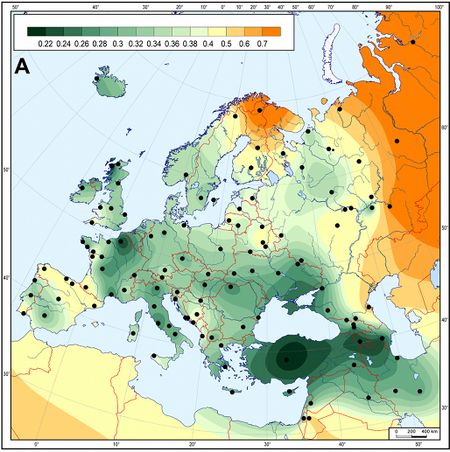انتشار إعماري

الانتشار الإعماري Demic diffusion هو مصطلح ديمغرافي يشير إلى نمط هجرة، طوّره لويجي كاڤالي-سفوردزا، لانتشار السكان في وعبر منطقة كانت غير مأهولة من تلك المجموعة من قبل، وربما وليس بالضرورة، لتحل محل أو تختلط مع سكان كانوا موجودين من قبل (كما هو مُقترح لانتشار الزراعة في أرجاء أوروبا العصر الحجري الحديث وعدد من أحداث سلب الأراضي الأخرى).
في صيغته الأصلية، يتضمن نموذج الانتشار الإعماري ثلاث مراحل: (1) النمو السكاني، مدفوعًا بالموارد المتاحة الجديدة كما هو الحال بالنسبة للمزارعين الأوائل، و/أو التطورات التكنولوجية الأخرى؛ (2) الانتشار في مناطق ذات كثافة سكانية منخفضة. (3) اختلاط أولي محدود مع الشعوب التي يلاقونها في العملية.
الدليل
أظهر العمل النظري الذي قام به كاڤالي-سفوردزا أنه إذا لم يكن الاختلاط بين المزارعين المتزايدين والمجموعات المقيمة سابقًا من الصيادين والجامعين أمرًا فوريًا ، فستؤدي العملية إلى إنشاء تدرجات وراثية واسعة. لأن التدرجات العريضة ، التي تغطي معظم أوروبا من الجنوب الشرقي إلى الشمال الغربي ، تم تحديدها في الدراسات الوراثية التجريبية التي قام بها كاڤالي-سفوردزا، روبرت ر. سوكال، گويدو باربوجاني، الوناس شيخي وغيرهم، يبدو من المحتمل أن انتشار الزراعة في أوروبا حدث بسبب توسع وانتشار المزارعين ، ربما نشأ في الهلال الخصيب في منطقة الشرق الأدنى. ويشار إلى ذلك بنموذج الانتشار الإعماري النيوليتي.
كما توصلت دراسات قياس الجماجم[2][3] و الآثار[4][5][6][7][8] لنفس الاستنتاج.
المراجع
- Chicki, L; Nichols, RA; Barbujani, G; Beaumont, MA. 2002. Y genetic data support the Neolithic demic diffusion model. Proc. Natl. Acad. Sci. 99(17): 11008-11013.
- ^ Consortium, the Genographic; Cooper, Alan (9 November 2010). "Ancient DNA from European Early Neolithic Farmers Reveals Their Near Eastern Affinities". PLOS Biology (in الإنجليزية). 8 (11): 1–20. doi:10.1371/journal.pbio.1000536. ISSN 1545-7885. PMC 2976717. PMID 21085689.
{{cite journal}}: CS1 maint: unflagged free DOI (link) - ^ C. Loring Brace, Noriko Seguchi, Conrad B. Quintyn, Sherry C. Fox, A. Russell Nelson, Sotiris K. Manolis, and Pan Qifeng, "The questionable contribution of the Neolithic and the Bronze Age to European craniofacial form," in Proceedings of the National Academy of Sciences of the United States (Jan. 3, 2006). Vol. 103, No. 1, pp. 242-247. [1] DOI:10.1073/pnas.0509801102
- ^ F. X. Ricaut, M. Waelkens, "Cranial Discrete Traits in a Byzantine Population and Eastern Mediterranean Population Movements," in Human Biology, Wayne State University Press (Aug. 2008). Vol. 80, Issue 5, pp. 535-564. [2] DOI:10.3378/1534-6617-80.5.535
- ^ M. Zvelebil, in Hunters in Transition: Mesolithic Societies and the Transition to Farming, M. Zvelebil (editor), Cambridge University Press: Cambridge, UK (1986) pp. 5-15, 167–188.
- ^ P. Bellwood, First Farmers: The Origins of Agricultural Societies, Blackwell: Malden, MA (2005).
- ^ M. Dokládal, J. Brožek, Curr. Anthropol. 2 (1961) pp. 455–477.
- ^ O. Bar-Yosef, Evol. Anthropol. 6 (1998) pp. 159–177.
- ^ M. Zvelebil, Antiquity 63 (1989) pp. 379–383.
وصلات خارجية
- Estimating the Impact of Prehistoric Admixture on the Genome of Europeans, Dupanloup et al., 2004
- Origin, Diffusion, and Differentiation of Y-Chromosome Haplogroups E and J: Inferences on the Neolithization of Europe and Later Migratory Events in the Mediterranean Area, 2004
- Y genetic data support the Neolithic demic diffusion model, Chikhi 2002.
- Paleolithic and Neolithic lineages in the European mitochondrial gene pool, Cavalli-Sforza 1997.
- Clines of nuclear DNA markers suggest a largely Neolithic ancestry of the European gene, Chikhi 1997.